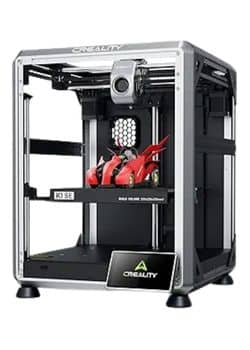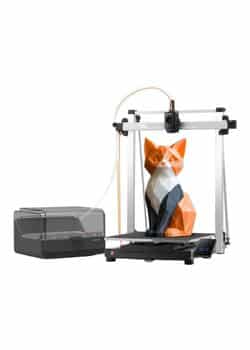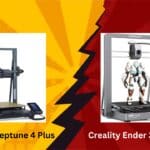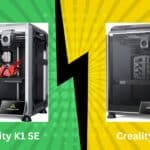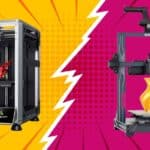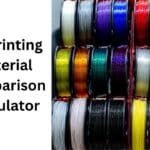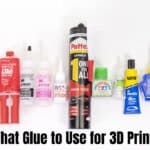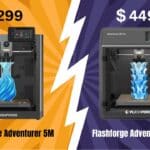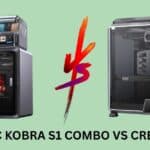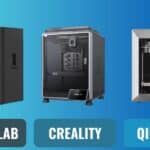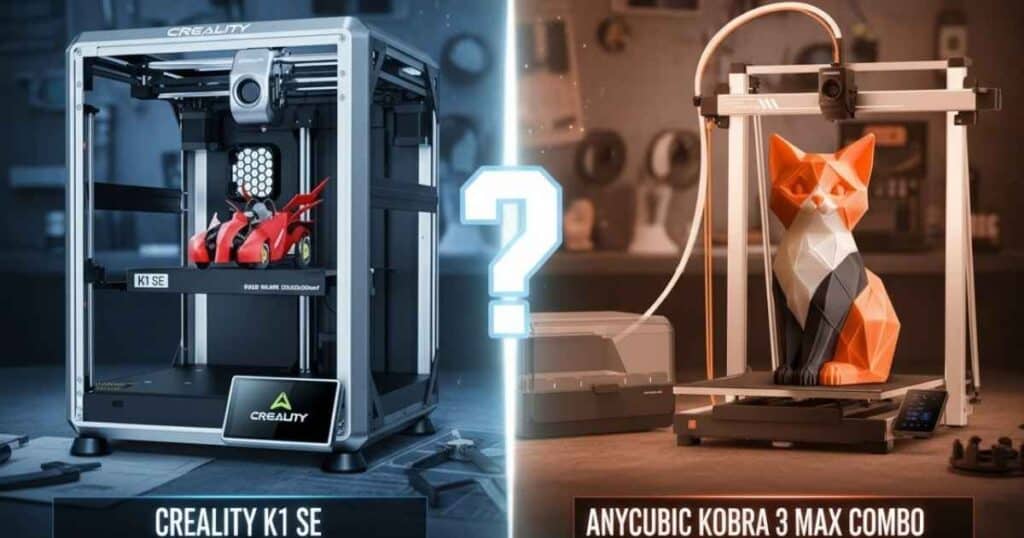
Tired of slow print times and monochrome models? The world of 3D printing is rapidly evolving, bringing incredible speed and vibrant color to your fingertips. But when it comes to upgrading your workshop or diving into advanced projects, two titans stand out: the Creality K1 SE and the Anycubic Kobra 3 Max Combo. Both promise to revolutionize your printing experience, yet they cater to very different aspirations.
Affiliate Disclosure
We participate in Amazon affiliate programs, earning fees from qualifying purchases via links at no extra cost to you. It’s how we keep this blog rolling and my 3D printers buzzing with fresh filament for reviews like this one!
Are you a precision enthusiast chasing blazing-fast speeds and the ability to conquer tough engineering materials in a compact, enclosed machine like the K1 SE? Or does your imagination lean towards colossal, multi-color masterpieces that fill vast spaces, brought to life by the expansive Kobra 3 Max Combo and its innovative ACE Pro system?
This isn’t just a comparison; it’s a guide to your next creative leap. We’ll meticulously break down every feature, from their core mechanics to their ecosystem, to help you pinpoint which printer is the ultimate champion for your unique 3D printing journey. Let’s discover which machine will truly elevate your decor projects and beyond!
(Looking for more options? Check out our guides on the Top 10 Multi-Extruder 3D Printers in 2025 or the Best Multicolor 3D Printers of 2025 for a broader view.)
Creality K1 SE: A Speed Demon with Precision and Versatility
The Creality K1 SE emerges as a formidable player in the high-speed FDM segment, inheriting the robust CoreXY system from its acclaimed K1 series. Designed for both eager beginners and seasoned enthusiasts, it promises an ‘out-of-box’ experience with professional-grade results.
K1 SE: At a Glance
✅ Blazing 600mm/s Speed & CoreXY Kinematics: Delivers fast, stable, and high-quality prints.
✅ Fully Enclosed Design: Perfect for printing advanced, warp-prone materials like ABS and Nylon.
✅ Flagship Extruder with Tri-metal Nozzle: Ensures precise feeding and high-temperature capability (300℃).
✅ One-Click Auto-Calibration: Effortless setup and perfect first layers, ideal for beginners.
✅ Open-Source Klipper OS: Allows for deep customization and advanced tuning.
✅ Exceptional Value: High-performance features at a budget-friendly price point.
❌ No Native Multi-Color Printing: Limited to single-color prints out of the box.
❌ Smaller Build Volume: Max 250x220x220mm, not suitable for very large single-piece objects.
❌ No Active Filament Drying: Relies on the enclosure, not dedicated drying, to manage moisture.
(Curious about similar printers? See our comparison: Creality K1 SE vs. Creality K1C or Creality K1 SE vs. Flashforge Adventurer 5M. For beginners, don’t miss our Top 3D Printer Picks for Beginners.)
Anycubic Kobra 3 Max Combo: Go Big and Go Bold with Color
The Anycubic Kobra 3 Max Combo, on the other hand, makes its mark with an undeniably massive build volume and a groundbreaking approach to multi-color printing. This machine is built for those who envision life-sized projects and wish to infuse them with a spectrum of colors.
Kobra 3 Max Combo: At a Glance
✅ Massive 420x420x500mm Build Volume: Create truly colossal, single-piece models.
✅ Amazing Multi-Color Printing with ACE Pro: 4-color (expandable to 8-color) capabilities for vibrant designs.
✅ Intelligent AI Recognition: Real-time print monitoring for “spaghetti” detection and failure prevention.
✅ ACE Pro Filament Management: Automatic switching, active drying (up to 55°C), and RFID sync for reliable multi-material prints.
✅ High-Speed Printing: Achieves 600mm/s despite its large Cartesian build.
✅ Precise LeviQ 2.0 Auto-Leveling: Ensures excellent first layers on its huge print bed.
❌ Open-Frame Design: Not ideal for warp-prone engineering materials without an external enclosure.
❌ Cartesian Kinematics: Large moving bed can introduce more vibration at extreme speeds compared to CoreXY.
❌ Locked Klipper Firmware: Limits advanced user customization.
❌ Higher Initial Investment: Significantly more expensive, especially for 8-color setup.
❌ No TPU for Multicolor: Cannot print flexible TPU through the ACE Pro for multi-color projects.
(Considering the Kobra series? Read our Anycubic Kobra 3 Review or compare it to other models like the Anycubic Kobra S1 Combo vs Bambu Lab P1S.)
Head-to-Head Comparison Categories
1. Build Volume & Design
The most striking difference between these two printers lies in their physical dimensions and design philosophy.
Creality K1 SE:
With a print volume of 250x220x220mm, the K1 SE is a compact powerhouse. Its fully enclosed metal frame, crafted with integrated die-casting and reinforced with corner gussets, provides exceptional rigidity and stability. This enclosed design is not just about aesthetics; it’s a critical feature for managing print environments, which we’ll delve into later. The K1 SE is designed for efficiency and precision, fitting comfortably into smaller workspaces while delivering high-quality results.
Anycubic Kobra 3 Max Combo:
The Kobra 3 Max Combo is a behemoth in comparison, offering an astounding 420x420x500mm jumbo-sized build area. This massive space means you can print truly colossal objects, from multi-color wall art to large-scale cosplay props, without the need for splitting and gluing parts. Its design is an open-frame Cartesian bed-slinger, typical for such large formats. While this open design allows for greater accessibility to the print bed, it does come with certain considerations for material compatibility.
- Implications: If your projects consistently involve large, single-piece models like architectural prototypes, large functional parts, or elaborate cosplay items, the Kobra 3 Max Combo’s sheer build volume is an undeniable advantage. For those with smaller projects or limited space, the K1 SE offers a more practical footprint.
2. Printing Speed & Kinematics
Both printers boast impressive speeds, but they achieve them through fundamentally different mechanical architectures.
Creality K1 SE:
Leveraging a CoreXY kinematics system, the K1 SE can achieve a maximum print speed of 600mm/s and 20000mm/s² acceleration. CoreXY systems are renowned for their inherent stability at high speeds because the print head moves in X and Y axes with two stationary motors, reducing moving mass on the gantry. This results in fewer vibrations and less “ringing” (ghosting artifacts) on prints, even when pushing the speed limits. The K1 SE also features active input shaping and a dynamically balanced part cooling fan to further mitigate vibrations and ensure consistent print quality.
Anycubic Kobra 3 Max Combo:
The Kobra 3 Max Combo employs a Cartesian-style bed-slinger design. In this setup, the print bed moves along the Y-axis, while the print head moves along the X and Z axes. Despite being a bed-slinger, Anycubic has optimized its Kobra OS firmware and incorporated SG15 high-precision bearings and a dual-axis core design to reach speeds of up to 600mm/s with 10000mm/s² acceleration. While these speeds are impressive for a Cartesian printer, the inherent movement of the large print bed can introduce more vibration, especially with taller or heavier prints, compared to a CoreXY system. The Kobra 3 Max likely utilizes robust vibration compensation to achieve its stated quality at high speeds.
- Practical Differences: For consistent, high-speed precision across various print sizes, especially intricate ones, the K1 SE’s CoreXY system offers a mechanical advantage. The Kobra 3 Max Combo excels at rapidly printing large objects, where overall speed of completion might outweigh the microscopic differences in surface finish due to kinematics.
3. Print Quality & Precision
High speed means little without high quality. Both printers offer features aimed at delivering excellent results.
Creality K1 SE:
Equipped with a flagship direct extruder featuring a newly added side spring & ball plunger, the K1 SE ensures precise filament feeding for consistent extrusion. Its durable tri-metal nozzle (steel-tipped copper integrated with a titanium alloy heatbreak) and 60W ceramic hotend (heating to 300℃ in 75s) enable it to melt and print various filaments efficiently. This setup, combined with Klipper-based features like linear advance and input shaping, contributes to crisp details and smooth surface finishes. The enclosed design also indirectly aids print quality by maintaining a stable printing environment.
Anycubic Kobra 3 Max Combo:
While specific hotend and extruder details are less emphasized in the provided data, the Kobra 3 Max Combo’s ability to achieve high speeds with its build volume suggests a high-flow hotend is in place. The LeviQ 2.0 auto-leveling system is designed for precise bed mapping, ensuring an excellent first layer – critical for large prints. Its “Intelligent Printing” feature, with AI recognition for real-time monitoring of “spaghetti” failures, is a significant innovation for maintaining print quality, especially during long, unattended prints or bulk production. The Kobra 3 Max Combo also features anti-skip upgrades for reliable filament handling.
- Verdict: Both aim for high quality. The K1 SE focuses on mechanical stability (CoreXY) and robust thermal components for precision. The Kobra 3 Max Combo leverages intelligent monitoring and its advanced auto-leveling for reliable quality, particularly on its large prints.
4. Features & User Experience
Modern 3D printers prioritize user-friendliness and smart features.
Auto-Leveling & Calibration:
- Creality K1 SE: Offers one-click auto-calibration and Z-offset, completely automating the bed leveling process. This ‘tap and walk away’ functionality makes it incredibly easy for beginners and saves time for experienced users.
- Anycubic Kobra 3 Max Combo: Features the LeviQ 2.0 auto-leveling system, a highly regarded and precise method for creating an accurate mesh of the print bed, ensuring optimal first-layer adhesion.
User Interface & Connectivity:
- Creality K1 SE: Runs on open-source Creality OS (based on Klipper), providing advanced functions and allowing users to customize it or join an open-source community for further exploration. It connects via USB and Wi-Fi, and integrates with Creality Cloud for a diverse, all-in-one 3D printing platform, including remote control and monitoring via PC and mobile apps.
- Anycubic Kobra 3 Max Combo: Features a 4.3-inch adjustable touchscreen for intuitive on-device controls. It operates on the Kobra OS firmware platform, which is likely Klipper-based but with restricted user access, limiting advanced customization for tinkerers. Connectivity includes Wi-Fi, allowing for remote monitoring and control via the Anycubic App, further enhanced by an optional 720p camera (user-installed) for real-time print observation.
Enclosure & Temperature Control:
- Creality K1 SE: Comes fully enclosed with a metal frame and transparent door/lid. This enclosure is crucial for printing high-temperature and warp-prone materials like ABS, ASA, PC, and Nylon, as it maintains a stable internal temperature. It also includes an anti-vibration fan and an activated carbon filter for improved air quality.
- Anycubic Kobra 3 Max Combo: Is an open-frame printer. While this makes the build area highly accessible, it means temperature-sensitive filaments will be prone to warping without an external enclosure (e.g., a tent or custom-built solution). This is a significant distinction for users planning to print engineering-grade materials.
Multi-Material/Color Capability (Crucial for Kobra 3 Max Combo):
- Anycubic Kobra 3 Max Combo with ACE Pro: This is where the “Combo” truly shines. The Anycubic ACE Pro is a sophisticated filament management system. Each unit holds 4 spools (1kg each), enabling 4-color printing. By pairing two ACE Pro units together, you can achieve brilliant 8-color printing via an 8-color filament hub. The ACE Pro offers:
- Automatic Filament Switching: Seamless color changes via a filament hub.
- Humidity Control: A sealed space with dual 200W PTC heating elements maintains up to 55°C for active filament drying, essential for moisture-sensitive materials. (For more on this, check out our guide on The Best Filament Dryers for 3D Printing.)
- Run-Out Detection & Entanglement Detection: Pauses prints or switches spools if issues arise.
- RFID Sync: Automatically detects Anycubic’s Intelligent Identification Filaments for optimal settings.
- Limitation: TPU is not supported for multicolor printing through the ACE Pro due to tangling risks, though it can be used as a single-color spool holder.
- Creality K1 SE: Does not natively support multi-color printing. While third-party multi-material units or future Creality AMS systems might become compatible, out-of-the-box it is a single-color printer. (If multicolor is a must for Creality, consider models like the Creality K2 Plus Combo or their CFS Multicolor Filament System.)
5. Material Compatibility
The types of materials a printer can handle dictate the range of projects it can undertake.
Creality K1 SE:
With its 300℃ hotend and fully enclosed design, the K1 SE is highly versatile. It natively supports common filaments like Hyper PLA, PLA, PETG, and TPU. Crucially, its enclosure allows it to comfortably print high-temperature and warp-prone engineering filaments such as ABS, ASA, PC, PA (Nylon), and even carbon fiber-infused materials, ensuring successful prints without warping.
Anycubic Kobra 3 Max Combo:
The Kobra 3 Max Combo supports standard materials like PLA, PETG, and basic TPU. While its high-temperature hotend (details not explicitly provided but implied by speed) could technically melt more advanced filaments, its open-frame design is a significant limitation for materials that require a warm, stable ambient ambient temperature to prevent warping (e.g., ABS, ASA, PC, Nylon). For these materials, an external enclosure would be a necessary addition. The ACE Pro, however, excels at pre-drying moisture-sensitive filaments like PLA and PETG, improving their print quality.
- Recommendation: If you plan to frequently print with advanced engineering materials that require consistent heat, the K1 SE’s enclosure is a major advantage. For artistic prints, large functional parts in standard plastics, or if you’re willing to add an external enclosure, the Kobra 3 Max Combo remains a strong choice. (Learn more about filament compatibility and advanced filaments.)
6. Ease of Assembly & Setup
Getting started quickly is a big plus for any user.
Creality K1 SE:
Designed for an “out-of-the-box experience,” the K1 SE comes pre-assembled and pre-tuned. Users report being able to go from unboxing to their first print in as little as 3 minutes, similar to setting up a new smartphone. Its one-click auto-calibration further streamlines the process.
Anycubic Kobra 3 Max Combo:
While generally user-friendly, the Kobra 3 Max Combo requires a bit more assembly. User reviews indicate it takes approximately 2 hours to fully set up, especially if you’re installing the ACE Pro unit(s) and any optional cameras. After assembly, the LeviQ 2.0 auto-leveling assists with quick calibration.
- Verdict: The K1 SE offers a faster, more immediate plug-and-play experience, ideal for those who want to start printing almost instantly. The Kobra 3 Max Combo’s setup, while not overly complex, demands a bit more time.
7. Price & Value Proposition
Value is more than just the sticker price; it’s about what you get for your investment and what it enables you to create.
Creality K1 SE:
- Current Price: Approximately $248.99 (often with limited-time deals).
- Value: For its price, the K1 SE offers exceptional value as a high-speed, fully enclosed CoreXY printer. It’s a flagship-level machine capable of advanced material printing, making it a powerful tool for a surprisingly low entry cost. It represents a fantastic upgrade for users coming from older, slower bed-slinger printers.
Anycubic Kobra 3 Max Combo:
- Bundle Price: Approximately $649.99 (bundle with one ACE Pro, often on sale from $789.98).
- 8-Color Upgrade: To achieve 8-color printing, you would need a second ACE Pro unit (approx.
350standalone)andan8−colorfilamenthub.Thismeansan8−colorsetupcouldtotal∗∗ 350standalone)andan8−colorfilamenthub.Thismeansan8−colorsetupcouldtotal∗∗1,000 or more**, depending on specific bundle deals. - Value: The Kobra 3 Max Combo’s value proposition is centered around its massive build volume and the multi-color capabilities offered by the ACE Pro. For large-scale, vibrant prints, it provides a unique and compelling solution. The AI monitoring and active filament drying from the ACE Pro add significant value for complex and long prints.
- Consideration: The K1 SE is a clear winner for budget-conscious buyers seeking a high-performance single-color printer. The Kobra 3 Max Combo, while more expensive, justifies its price with its unparalleled print volume and integrated multi-color system, making it a strong contender for those whose projects demand these specific features.
8. Software & Ecosystem
The software experience is crucial for a smooth workflow.
Creality K1 SE:
Runs on an open-source Creality OS based on Klipper, providing users with a highly customizable and advanced control platform. This appeals to tinkerers and those who enjoy fine-tuning their printer’s performance. It’s compatible with popular slicers like Creality Print (recommended), Cura, and PrusaSlicer. The Creality Cloud platform provides cloud slicing, remote monitoring, and a vast library of models.
Anycubic Kobra 3 Max Combo:
Officially recommends Anycubic Slicer Next, a proprietary slicer based on OrcaSlicer but optimized for Anycubic printers and multi-color profiles. While it supports advanced features and cloud integration, it may lag behind the bleeding edge of open-source OrcaSlicer updates. It is also compatible with Cura and OrcaSlicer, though Anycubic Slicer Next is recommended for the best multi-color experience. The Kobra OS firmware, while Klipper-based, has locked-down user access, which can be a drawback for advanced users seeking deep customization.
- Verdict: The K1 SE offers more open-source flexibility for power users. The Kobra 3 Max Combo provides a more streamlined, though less customizable, ecosystem, particularly optimized for its multi-color printing. (For more insights into slicer software, check out our guide: Best Slicing Software for 3D Printing.)
Comparison Table: Creality K1 SE vs Anycubic Kobra 3 Max Combo
| Feature | Creality K1 SE | Anycubic Kobra 3 Max Combo |
|---|---|---|
| Print Volume | 250x220x220mm (9.8″x8.7″x8.7″) | 420x420x500mm (16.5″x16.5″x19.7″) |
| Max Print Speed | 600mm/s | 600mm/s |
| Kinematics | CoreXY | Cartesian (Bed-Slinger) |
| Enclosure | Fully Enclosed | Open-Frame |
| Multi-Color | No (single color) | Yes (4 colors w/ 1 ACE Pro, 8 colors w/ 2 ACE Pros) |
| Auto-Leveling | One-click Auto Calibration & Z-Offset | LeviQ 2.0 Auto-Leveling |
| Hotend Temp | 300°C (Tri-metal nozzle) | Not explicitly stated (high-flow implied) |
| Firmware | Open-source Creality OS (Klipper-based) | Kobra OS (Klipper-based, locked access) |
| Slicer Support | Creality Print, Cura, PrusaSlicer | Anycubic Slicer Next, Cura, OrcaSlicer |
| Connectivity | USB, Wi-Fi (Creality Cloud) | Wi-Fi (Anycubic App, Optional Camera) |
| Filament Drying | No (enclosure helps) | Yes (ACE Pro actively dries up to 55°C) |
| Price (approx.) | ~$249 | ~$650 (with 1 ACE Pro); ~$1000+ (with 2 ACE Pros) |
Real-World Scenarios / Who Should Buy Which?
Choosing between these two printers ultimately boils down to your specific needs and ambitions:
Choose the Creality K1 SE if…
- You prioritize speed, precision, and material versatility for a wide range of projects, from rapid prototyping to functional prints.
- You need to print frequently with advanced engineering filaments (ABS, ASA, PC, Nylon) that require a stable, enclosed printing environment.
- Your projects are generally within the 250x220x220mm size range. (For larger enclosed options, explore QIDI Max3 comparisons.)
- You value an “out-of-the-box,” hassle-free setup and a printer that just works.
- You appreciate the flexibility of open-source Klipper firmware for potential future customization.
- You’re looking for flagship performance at an incredibly attractive price point.
Choose the Anycubic Kobra 3 Max Combo if…
- Your primary goal is to print truly massive, life-sized objects that other printers can’t handle in one piece.
- Multi-color printing is a core requirement for your creative or functional projects, and you want an integrated, intelligent system to manage it. (Also consider our Top Multi-Color 3D Printers in 2025.)
- You frequently print with moisture-sensitive filaments (PLA, PETG) and appreciate the active drying capabilities of the ACE Pro.
- You are happy with an open-frame printer or are willing to invest in an external enclosure for advanced materials.
- You value intelligent AI monitoring that can save prints from catastrophic failures.
- You’re willing to invest a higher budget for the unique combination of huge build volume and multi-color capability.
FAQs
Is the Creality K1 SE good for beginners?
✅ Yes, absolutely! Despite its advanced capabilities, the K1 SE is highly beginner-friendly thanks to its pre-assembly, one-click auto-calibration, and intuitive interface. Many users report printing within minutes of unboxing.
Can the Anycubic Kobra 3 Max Combo print multiple colors?
✅ Yes! With the included Anycubic ACE Pro unit, the Kobra 3 Max Combo can print in 4 colors. If you add a second ACE Pro unit and an 8-color filament hub, you can achieve stunning 8-color prints. (For more on this, read our Anycubic Kobra 3 Max Combo review.)
What’s the main difference between CoreXY and Cartesian kinematics?
CoreXY (like the K1 SE) uses two stationary motors to move the print head in both X and Y axes, resulting in a lighter moving mass, better stability, and less vibration at high speeds. Cartesian (like the Kobra 3 Max Combo) often involves the print bed moving along one axis, which can introduce more vibration, especially with large, fast movements, but can still achieve high speeds with proper optimization.
Are there any common issues with either printer?
❌ Some early K1 SE units faced minor firmware bugs or fan noise, which Creality has actively addressed with updates. The Kobra 3 Max Combo, being a bed-slinger, might experience more noticeable vibration at its highest speeds with very tall prints, though Anycubic includes mitigation features. Some users also note the locked nature of Kobra OS as a limitation for deep customization.
Can I print flexible filaments like TPU with both printers?
✅ Yes, both printers can print TPU. The Creality K1 SE, with its direct drive extruder, handles TPU very well. However, it’s important to note that ❌ TPU is not supported for multi-color printing through the ACE Pro due to entanglement risks in its feeding system. (For more on TPU filament, check out our guide.)
Conclusion
Both the Creality K1 SE and the Anycubic Kobra 3 Max Combo represent the pinnacle of modern FDM 3D printing, each a powerful tool in its own right. Your choice hinges on your primary ambitions.
If your projects demand uncompromising speed, precision, the ability to work with advanced engineering materials in a controlled environment, and exceptional value, the Creality K1 SE is an outstanding choice. It’s a high-performance workhorse that’s both beginner-friendly and capable of satisfying seasoned experts.
However, if your vision involves creating truly monumental models, infusing them with a vibrant spectrum of colors, and benefiting from intelligent filament management, then the Anycubic Kobra 3 Max Combo is your ultimate companion. Its sheer build volume and advanced multi-color capabilities open up a new realm of creative possibilities.
Consider your workflow, your budget, and the types of prints you dream of bringing to life. Make your choice wisely, and happy printing!
- Ready for high-speed, enclosed printing? Check out the Creality K1 SE on Amazon!
- Dreaming of massive, multi-color creations? Explore the Anycubic Kobra 3 Max Combo with ACE Pro!
- Need more colors for your Kobra 3 Max Combo? Find the standalone Anycubic ACE Pro here! (Please replace with your actual affiliate link)
- Optimize your prints with the right slicer! Download Cura here or explore OrcaSlicer. (For more detail, dive into our Best Slicing Software for 3D Printing guide.)

